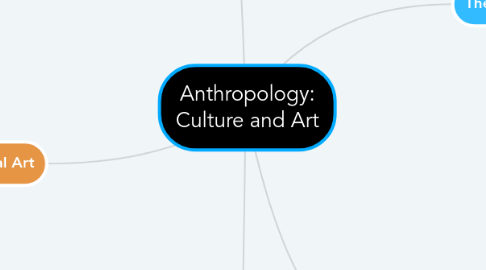Anthropology: Culture and Art
Door Nathaniel Padua

1. Interesting Quote: "By the beginning of the nineteenth century, Scandinavian scholars were confirming the sequence of Stone, Bronze, and Iron Ages already inferred from Genesis, on the basis of systematic excavation of ancient sites." (Burt, p. 69)
1.1. "Prehistoric" art encompasses art that was made before written records -- many examples of "prehistoric" art include paleolithic cave art (imagery displayed on the walls of caves/"rock" art) and paleolithic figurines (like the Willendorf Venus)
1.2. Prehistoric Art
2. Primitive Art
2.1. Interesting Quote: "Since larger societies had evidently developed from smaller ones, as recorded history showed, contemporary small societies, which seemed to have no history, were presumed to suffer various kinds of racial or cultural deficiencies." (Burt, p, 53)
2.1.1. "Primitive" art is a European concept that describes art originating from "primitive" societies -- that is, societies viewed (from a European perspective) as being less advanced and resistant to change.
2.1.2. Interesting Quote: “At the same time, more people learned a greater range of the social, cultural, and technical skills required to participate creatively in the artistic traditions of their society. While supporting the local communities they depended on, such egalitarian peoples saw no reason to admit the superiority of outsiders and often resisted colonial conquest as fiercely as they could.” (Burt, p. 54)
3. Oriental Art
3.1. Interesting Quote: "Islamic art is not a category recognized by Muslims, even by the connoisseurs who treat calligraphy and book illustration much as Westerners treat fine art. Nor is there much interest in Islamic art in Muslim countries, despite the support that the oil states have given it through sponsorship in the West." (Burt, p. 42)
3.2. "Orientalism" can be defined as the European ideology that attributes East Asian and Central Asian cultures as "strange" or "exotic" in nature -- Orientalism established the groundwork that ultimately creates a separation between the perception of European societies and that of East and Central Asian societies.
3.3. Action movies made in the past that take place in the Middle East often have subtle "Oriental" undertones to them, often portraying these societies in the Middle East as "barbaric" and "cruel."
4. The Origins of Art
4.1. Interesting Quote: "By the eighteenth century, the European elite had identified the knowledge and skill to create beautiful, thought-provoking images as an art superior to the production of other artefacts and had established as disciplines the history of art (or at least of artists) and the connoisseurship of artistic value." (Burt, p. 11)
4.2. The Origins of Art reach as far back as petroglyph-rock cravings and engravings, geometric symbols, primitive humanoid objects etc... -- this displays one of the first instances of human creative and expression.
4.3. Throughout the years, the definition of "art" has expanded far beyond visual illustrations of human thought and creative and has encompassed aspects such as dance and music.
5. Classical Art
5.1. Art from the ancient Greeks and Romans are widely regarded as "classical" pieces of art and reflect the superior European view of art and expression.
5.2. Interesting Quote: "From the mid-nineteenth century, art historians traced and theorized artistic developments from Classical antiquity through the Middle Ages and Renaissance to the modern world, under the assumption that art was self-evidently a property of a progressively evolving European civilization." (Burt, p. 29-30)


